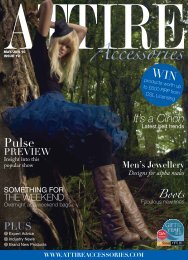Low-resolution PDF (11Mb) - Attire Accessories magazine
Low-resolution PDF (11Mb) - Attire Accessories magazine
Low-resolution PDF (11Mb) - Attire Accessories magazine
You also want an ePaper? Increase the reach of your titles
YUMPU automatically turns print PDFs into web optimized ePapers that Google loves.
with your business supplying the prize. You can<br />
even send letters or press releases to the editor<br />
on business topics using your business address.<br />
Writing a press release<br />
When writing your press release you should bear<br />
in mind the six key points:<br />
• Who is the release from?<br />
• What is it about?<br />
• Where are you based?<br />
• When is it happening?<br />
• How can your customers take advantage of<br />
what you are doing?<br />
• Why are you doing it?<br />
Your title should be about six or seven words<br />
long and sum up the story. Your press release<br />
should be written in the third person as if it were<br />
an article – you should say ‘Bridal Business is<br />
moving to new premises’ not ‘we are moving to<br />
new premises’. Resist the temptation to turn your<br />
release into an advert so avoid self-promotion<br />
and don’t use unqualified superlatives – stick<br />
to the facts. Use short, concise sentences and<br />
clear English and always proof read your release<br />
before sending it: you can ask someone else to<br />
check it through if writing isn’t your strong point.<br />
The first paragraph should sum up the whole<br />
story and should still make sense even if the rest<br />
of the press release was cut out. The following<br />
paragraphs should give more detail and can<br />
include a quote from you.<br />
At the end of the story type ‘end’ and then<br />
include your name and telephone number so the<br />
press can contact you for further details. If there<br />
is any extra information which would be helpful,<br />
such as a brief biography or history of your<br />
business, you can include it in ‘editor’s notes’ at<br />
the end.<br />
A photo helps to attract attention. You should<br />
always have people in the shot if its possible<br />
so, if you are moving to new premises, take a<br />
high <strong>resolution</strong> shot of you and your staff at the<br />
new building.<br />
You can write one press release and send it<br />
to several different targets – but you may need to<br />
tailor it to make it more appropriate for different<br />
publications. Magazines have varying styles so<br />
look at articles in your target publication and copy<br />
their style.<br />
Once you’ve finished your release you should<br />
send it out by email as papers and <strong>magazine</strong>s<br />
may just cut and paste from a well written email<br />
press release. Put ‘Press release’ and your<br />
headline in the subject of the email and again<br />
in the main body of the email, followed by the<br />
date, your press release text, contact details and<br />
editor’s notes.<br />
When sending the email always use the ‘Blind<br />
carbon copy’ to enter the names of the people<br />
you are sending the release to so that they can’t<br />
see the other recipients.<br />
Remember that if your story is about something<br />
which is ongoing then you can send a follow up<br />
release at a later date. For example, if you were<br />
taking part in a fundraising activity you could<br />
follow up with another release once you have<br />
reached your goal.<br />
Using a PR agency<br />
There are no hard and fast rules for when small<br />
businesses should use a PR consultant or<br />
agency. You should use your own judgement and<br />
look at your budget, what you want to achieve<br />
and how much time you are spending on doing<br />
your own PR, before paying for external help. You<br />
may feel that it’s worth paying a consultant on a<br />
day rate if you want help with one specific activity,<br />
rather than using someone on an ongoing basis.<br />
Whatever you decide be clear about what you<br />
want to achieve and always choose an agency or<br />
freelancer with relevant experience. Write a clear<br />
brief and check costs and what will be covered<br />
before you start.<br />
Dealing with bad publicity<br />
Although it’s unlikely, occasionally disgruntled<br />
employees or customers, mistakes or accidents<br />
����������������<br />
����������������<br />
can result in a negative story. Make sure that<br />
employees know to refer journalists to you and,<br />
if contacted by the press, check their deadline.<br />
Then write a clear statement showing that you<br />
have done everything that you reasonably could<br />
to deal with any problems and respond in time.<br />
Answer truthfully to any questions – although you<br />
don’t need to volunteer every detail.<br />
In conclusion<br />
PR is a long-term strategy not a quick fix, so<br />
in your planning you should think about what<br />
you would consider a success and set realistic<br />
objectives. You should track the coverage of<br />
each press release or activity and keep copies<br />
as well as putting them on your website and in<br />
your newsletter if you have them. Also, keep<br />
networking with your local business community<br />
and media – let them know what you are doing.<br />
Don’t let your business be the best kept<br />
secret – make the most of any publicity and tell<br />
everyone about it! �<br />
Further information<br />
For more details on Business Link, plus advice<br />
on marketing and PR visit the website<br />
www.businesslink.gov.uk or telephone<br />
+44 (0)845 600 9006.<br />
���������









